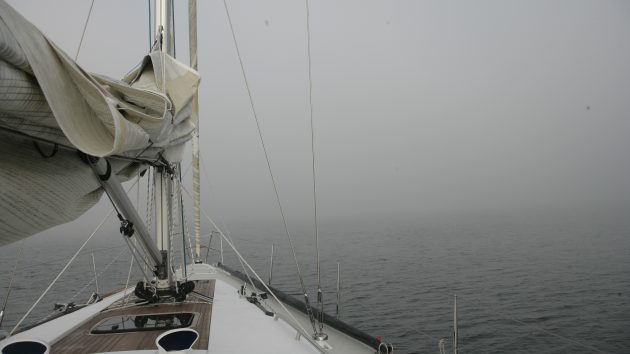With no electrics, would you sail towards a tidal headland in poor visibility? James Stevens answers your Questions of Seamanship
With no electrics, would you sail towards a tidal headland in poor visibility?
James Stevens answers your Questions of Seamanship
Question:
Ben and his wife Kate are enjoying an early season cruise in April in the Isles of Scilly.
Their boat is a much- loved Contessa 32.
It is Friday and they are currently on a mooring between Bryher and Tresco, the most sheltered spot for the forecast southwesterly Force 4.
Their plan is to make use of this favourable wind on Saturday to sail 60 miles back to their home port of Falmouth, although poor visibility is forecast.
On Saturday night a cold front will pass over and the wind will veer to a northwesterly Force 4 to 5, but windy weather is forecast for Monday and the rest of the week.
The weather is unsettled on Friday evening with thunderstorms forecast overnight.
As Ben and Kate settle down in their bunks they can hear the thunder. In the middle of the night there is a huge bang.

Credit: Maxine Heath
They wake up and reach for a light switch. No light. There is no electrical power.
They grab torches, realising the mast has been struck by lightning.
A check of the boat confirms that there does not appear to be any structural damage to the hull and boat rig but the electrical systems are inoperative, including the starter motor, the chartplotter and echo sounder.
After a fretful night they reinspect the yacht.
It seems OK to sail but the visibility is only about half a mile in the southwesterly Force 4 wind.
Even their mobile phones don’t work but they have paper charts showing the offlying rocks, tidal stream atlases and almanac.
Should they try to sail back? .
Answer:
It would take a brave skipper to sail across a Traffic Separation Scheme towards a difficult and tidal headland in poor visibility with no electric instruments.
Trying to maintain an estimated position with a level of accuracy with no log of distance, no echo sounder and no means of verifying position until land appears is a huge risk on a rocky coastline.

James Stevens, author of the Yachtmaster Handbook, spent 10 years as the RYA’s Training Manager and Yachtmaster Chief Examiner
They should therefore stay until the visibility clears.
In April, with a southwesterly wind, the most likely reason for the poor visibility is advection or sea fog. This should clear following the cold front.
Providing they are happy that the yacht is sound, once the visibility improves, sailing home is, navigationally, not too difficult as they will be in sight of land with some very clear features to give position lines and fixes.
While Ben and Kate are fogbound they could, of course, take a trip ashore, stock up, and, if they are worried about traditional navigation, purchase a portable GPS set.
They should also closely inspect the boat to check that it is sound and not taking water.
They need to make the decision on Saturday and leave on Sunday having worked out the most favourable time for the tidal streams to Falmouth.
Enjoyed reading Should you set off with no electrics?
A subscription to Yachting Monthly magazine costs around 40% less than the cover price.
Print and digital editions are available through Magazines Direct – where you can also find the latest deals.
YM is packed with information to help you get the most from your time on the water.
-
-
- Take your seamanship to the next level with tips, advice and skills from our experts
- Impartial in-depth reviews of the latest yachts and equipment
- Cruising guides to help you reach those dream destinations
-
Follow us on Facebook, Twitter and Instagram.





